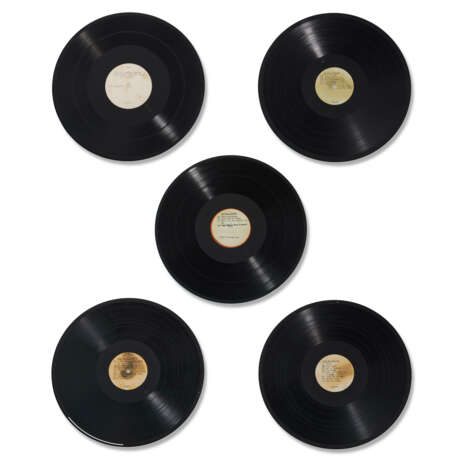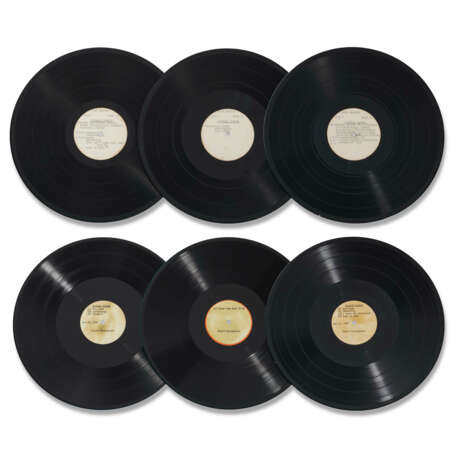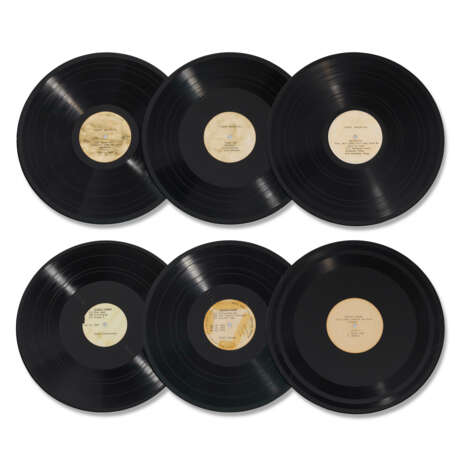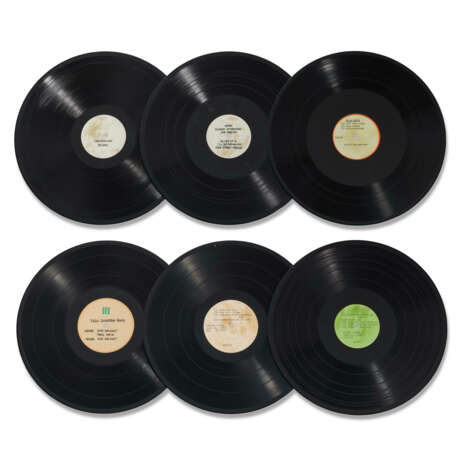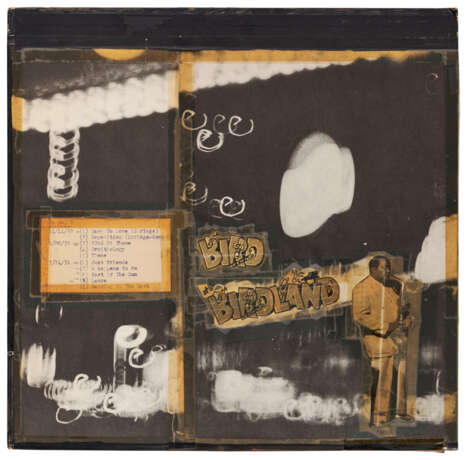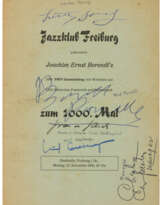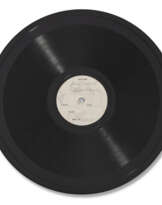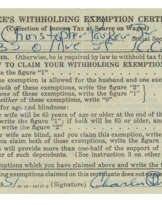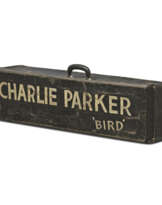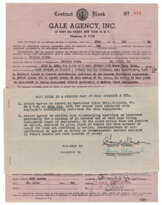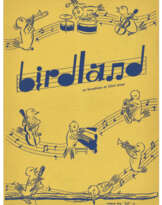A collection of 23 original 12-inch acetates of airshots, including 17 of Charlie Parker, from the archive of the legendary amateur recordist Boris Rose, 1948-53
28.09.2023 13:00UTC +00:00
Classic
Vendu
6300GBP £ 6 300
| Auctioneer | CHRISTIE'S |
|---|---|
| Lieu de l'événement | Royaume-Uni, London |
| Commission | see on Website% |
Archive
La vente aux enchères est terminée. Vous ne pouvez plus enchérir.

ID 1016475
Lot 178 | A collection of 23 original 12-inch acetates of airshots, including 17 of Charlie Parker, from the archive of the legendary amateur recordist Boris Rose, 1948-53
Valeur estimée
£ 8 000 – 12 000
Charles “Charlie,” Jr. Parker
PARKER, Charles “Charlie,” Jr. (1920-1955), Miles DAVIS (1926-1991), Lester YOUNG (1909-1959) et al.
A collection of 23 original 12-inch acetates of airshots, including 17 of Charlie Parker, from the archive of the legendary amateur recordist Boris Rose, 1948-53.
Boris Rose (1918-2000), a sound engineer from the Bronx, was by all accounts a compulsive collector who recorded radio performances and broadcasts, making homemade acetates and bootleg records available to jazz fans for decades. Writing about Rose’s extensive archive for the Wall Street Journal in 2010, William Friedwald remarked that he ‘was one of those legendary characters who seem to proliferate in the world of jazz… An inveterate prankster, he dreamed up a dizzying array of fake label names… many of which he tried to pass off as European imports… The truth was that Mr. Rose produced them all from his brownstone on East 10th Street. "I always felt something about jazz," Mr. Rose said in an undated interview with historian Dan Morgenstern… "As far back as 1930, I listened to broadcasts from the Cotton Club. I heard Duke, I heard Don Redman, I heard Cab Calloway… As far back as 1940, I purchased a home [disc-cutter] recorder and I began to dub records.” From there, he branched out to recording radio broadcasts and then live bands in clubs. "I had professional equipment and began to take down all of these jazz broadcasts," he explained. "First on 16-inch acetate discs. Later on, when tape came into the picture, I was able to record on tape."' Friedwald notes that ‘the centerpiece of the Rose archive is the Birdland Collection: Mr. Rose recorded virtually every band that played this most legendary of jazz joints, either directly off the airwaves or by smuggling a concealed tape recorder into the club.’ Over the years, he amassed an enormous archive, documenting an entire era of music. Highlights present here are Bird at St. Nicks, along with radio broadcasts from the Royal Roost, Birdland, the Band Box, Café Society, and Carnegie Hall, offering a remarkable overview of Charlie Parker’s live repertoire during this period. Other artists represented include Miles Davis, Fats Navarro, Count Basie, Lester Young, Bud Powell and Coleman Hawkins. ‘We should thank goodness that someone was documenting these broadcasts,’ proclaims music critic John Corbett, ‘or they might have been lost forever.’ Corbett, Vinyl Freak, November 2004. Cummings, Democracy of Sound, 65. Driggs and Haddix, ix. Friedwald, WSJ, 4 December 2010.
Twenty-three 12-inch acetates, the majority of the white labels with typewritten titles and track listings, some with handmade sleeves, the others with white card sleeves, some of the sleeves with handwritten track listings, the Charlie Parker recordings comprising:
- Bird at St. Nick’s, featuring the Charlie Parker Quintet with Red Rodney, Al Haig, Tommy Potter and Roy Haynes at St. Nicholas Arena, New York, 18 February 1950. Parker scholar Lawrence O. Koch notes: ‘There is a different parker here than on any other recording. He is extremely inventive and free, and there is much humour and abandon in his playing… an essential item’;
- Bird on 52nd Street, featuring Charlie Parker at the Onyx Club, New York, 6 July 1948, recorded by Dean Benedetti;
- Charlie Parker, one side featuring White Christmas, Slow Boat to China and This Time the Dream’s On Me, possibly at Royal Roost, New York, December 1948, the other side featuring Tiger Rag, presumably Dizzy Gillespie at WOR Studios, New York, 20 September 1947, and Dizzy Atmosphere and Rifftide, possibly at Café Society, New York, Autumn 1949 or Spring 1950, according to Koch, with dark green pebble grain sleeve inscribed ‘Charlie Parker’;
- Birdomania, one side featuring Lullaby in Rhythm at Café Society, New York, May/July 1950, and Lament for the Congo [Bongo Ballad] at Renaissance Ballroom, New York, 19 or 20 May 1950, the other side featuring Moose the Mooche and 52nd Street Theme at Café Society, New York, June/July 1950, with an attractive handmade sleeve;
- Charlie Parker, one side featuring Parker at Birdland, New York, 24 March 1951, the other featuring Parker at Carnegie Hall, New York, 14 November 1952, and at Birdland, 20 September 1952, with a handmade sleeve;
- Rose Records – Rose 20, featuring Charlie Parker at the Band Box, New York, on 16 February, 23 March and 30 March 1953, and at Birdland on 30 May 1953, white record sleeve with handwritten track listing;
- Charlie Parker, one side featuring Parker at the Band Box, New York, 30 March 1953, the other featuring an Interview with the Bird with Marshall Stearns and John Maher, New York, 1 May 1950. Koch refers to this as a ‘famous oral interview… Bird speaks of his parents and childhood, his musical beginnings and early experiences, his marriage and his son.’ Koch, 204.
- Another copy of the above, the white sleeve with handwritten track listing;
- Charlie Parker at the Café Society, New York, probably Spring 1950, with homemade paper sleeve;
- Charlie Parker, side one featuring Parker at Birdland, 23 May 1950, and side two possibly featuring Parker at Café Society, New York, June 1950;
- Rose Records – Rose 30, featuring Parker at Birdland on 24 March 1951 and 20 September 1952, the latter date with Charles Mingus, the white paper sleeve with handwritten track listing;
- Parker Broadcasts, featuring Charlie Parker at the Royal Roost, New York, 12 December 1948, 12 February, 26 February and 5 March 1949, the white paper sleeve with handwritten track listing;
- Parker Broadcasts, side one featuring Parker with Dizzy Gillespie at WOR Studios, New York, 20 September 1947, and at the Waldorf Astoria, New York, 5 March 1949, side two featuring five tracks almost certainly from a tribute concert commemorating Duke Ellington’s 25 years as leader at Carnegie Hall, 14-15 November 1952, broadcast by WNBC Radio, the white paper sleeve with handwritten track listing. Koch notes that the 20 September 1947 date at WOR Studios is ‘unbelievable and must be heard by anyone interested in the music of the period’;
- Parker Broadcasts, featuring Parker at Birdland, 23 May 1950 and 7 April 1951, and at Café Society, New York, probably 1 June 1950, the white paper sleeve with handwritten track listing;
- Charlie Parker, featuring Parker at the Band Box, New York, 16 February, 23 March and 30 March 1953;
- Charlie Parker with Buddy Stewart and Dave Lambert, featuring Parker at the Royal Roost, New York, 5 March 1949, the white paper sleeve titled and dated in ink;
- Rose Records – Rose 31, featuring Parker at Birdland on 30 June 1950 and 7 April 1951, and at the Waldorf Astoria, New York, on 5 March 1949, the white paper sleeve with handwritten track listing;
the six further acetates including Fats Navarro with the Tadd Dameron Band, October 1948; Count Basie on CBS, 9 July 1938; Lester Young at Birdland, July 1953; Miles Davis at the Royal Roost, September 1948; and two WNEW Sunday Afternoon Jam Sessions; the collection housed in a carpet covered flight case. Provenance: Boris Rose (1918-2000; amateur recordist).
Further details
These recordings are offered for sale without copyright, broadcast rights, performers consents and other reproduction rights. The buyer must apply to the relevant parties to obtain such clearance and consents as may be necessary.
| Adresse de l'enchère |
CHRISTIE'S 8 King Street, St. James's SW1Y 6QT London Royaume-Uni | |
|---|---|---|
| Aperçu |
| |
| Téléphone | +44 (0)20 7839 9060 | |
| Commission | see on Website | |
| Conditions d'utilisation | Conditions d'utilisation |
